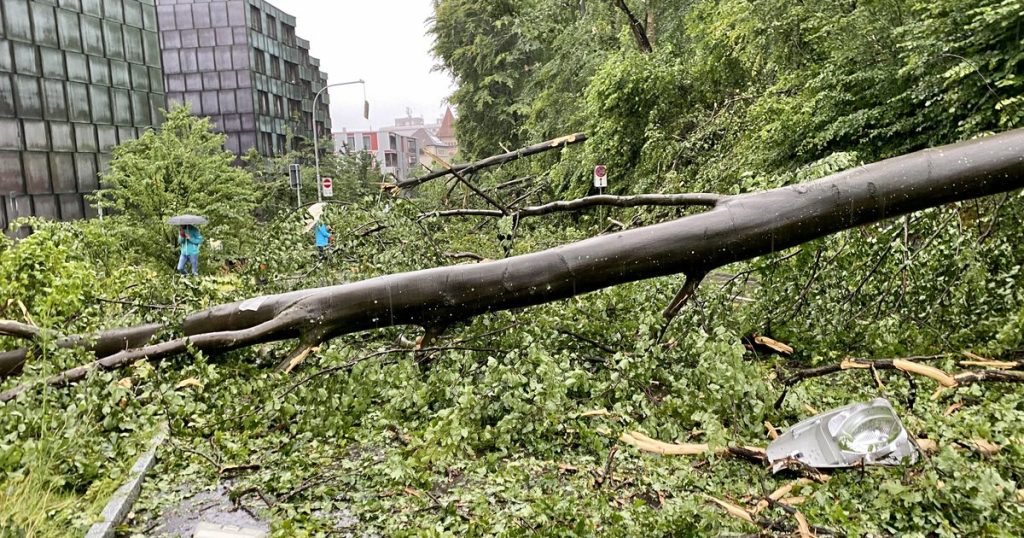
Thunderstorms in Zurich: ‘Ten times more frightening than earthquakes in New Zealand’
“this is my car!” German cheer. Buried under logs and branches, the car is not about to restart. It is impossible, even, to perceive the damage: a small thicket of branches, leaves and even trunks imprisons it. Her owner puzzled: they come? Who should I contact? “
It was barely seven in the morning in Zurich, and many residents of Gogachs Park, a complex of several buildings in the north of the city, turned up to witness the damage caused by violent storms from Monday through Tuesday night. Between two heavy rains, children climb on logs scattered in the street while adults photograph the damage from all angles.
“white horizon”
It was installed at the foot of the Käferberg, and residents had a seat next to the front row in the ring. Several huge trees in the forest were smashed on the way, sometimes hitting buildings when they fell. I heard nothing, but my husband watched the storm. Finally, it seems to be a way of speaking: We couldn’t see anything, the horizon was white with hail,” says Holly, a New Yorker who had just arrived in Switzerland. She may have seen some of the most spectacular floods in her city, but she’s still a fan. .
Just like this New Zealander, who recalls “We have earthquakes of a certain level fairly regularly. But this was 10 times more terrifying than anything I’ve seen in my life.” Isla said she “had the impression at times that it was a hurricane, so the winds were incredibly fast. My legs shook for 45 minutes after the storm because I was afraid our windows would blow out.”
Worse elsewhere
A little later, a road worker tries to untie the sewage system clogged with foliage with his bare hands. It’s ten in the morning when he tackles this particularly affected street with a colleague. It will take at least until the day after tomorrow, and perhaps longer, until she is freed from the remnants of the forest. The man was on board for three hours. It’s official: It’s not “the worst” here, he assures us. In Schwamenden, located to the northeast of the city, the damage was even more impressive, he says.
Read also:
Public transport in Zurich was disrupted due to the heavy rain that fell during the night
The night from Monday to Tuesday was marked by particularly violent thunderstorms in the canton of Zurich, with gusty winds (more than 100 km/h) and often hail. MeteoNews has recorded about 9,000 thunderbolts. According to SRF Meteo, 27.1 mm of rain fell in 10 minutes in Afoltern and 25 mm in Obvicon, two areas north of the city. Basridin was also severely affected. But in Waldig, behind the summit of Uetliberg, the shower was stronger: 31.1 mm, almost unprecedented. Lausanne set the Swiss record in 2018 (41 mm).
Emergency services say they received more than 1,000 emergency calls at the height of the bad weather. Firefighters had to intervene several hundred times, while electricity was cut off in some neighborhoods. But there were no reports of casualties during the night. Several train lines on the outskirts of Zurich have been temporarily cut. Trams circulated at a reduced rate before resuming work at the usual rate, while several buses were still parked in the morning. The rains have resumed strongly, and are expected to continue through the week, raising concerns about the level of the lake, and the Sihl and Limmat rivers, the two rivers crossing Switzerland’s largest city, which are threatening to flood.
Lake Zurich reached level 4 out of 5 (high risk of flooding) on Wednesday afternoon. As the rain continues, the water continues to rise. The canton warned that “the level of the Limmat River will continue to rise in the coming days due to the rising lake level,” and the canton estimates the possibility of local flooding around the Zurich rivers. Work was also done to reduce the water in Lake Sihl, whose river then flows into Limmat.
Situation, confirms Neue Zürcher Zeitung, remembers 2005, when Sihl was on the verge of flooding. It only took a little (it was then raining on the Bernese Oberland) that the city center was not under fifty centimeters of water over several square kilometres. It is this current that poses the most problems. Much of the city center is built into the Sihl’s alluvial fan, a natural floodplain. The Zurich daily warns that the fact that the entire surface – not just the protected areas – has now been built increases the risks.
see again:
And read again: Cold, thunderstorms and floods hit Switzerland: global warming suspected

“Reader. Travel maven. Student. Passionate tv junkie. Internet ninja. Twitter advocate. Web nerd. Bacon buff.”
